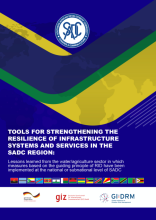Every year, billions of dollars are being invested into long-term infrastructure projects, however, their planning processes often fail to take account of future climate change and related impacts. This leads to high risks of damage and misguided investments that harbour potentially disastrous consequences for the economy and society at large. Against this background, climate risk and vulnerability assessments provide a valuable tool to identify risks at an early stage and thus creating scope for prioritizing actions to strengthen the resilience of critical infrastructure systems.
The Southern African Development Community (SADC) has made significant progress in advancing regional cooperation and integration since its establishment in 1980, contributing to economic development towards poverty reduction in the region. In this regard, strengthening transnational infrastructure networks and services has proven to play a crucial role in advancing regional integration in the SADC but also in ensuring access to or supply by systemrelevant critical infrastructures. Critical infrastructure refers to different assets, facilities, services, and systems that are essential for the social and economic functions, as well as the basic operations of a country and its government. In this priority area, the SADC can showcase Statement of Purpose This document draws attention to the need to systematically integrate climate change and risk considerations into infrastructure planning and decision-making processes in the SADC region.
To this end, it introduces a conceptually integrated approach of embedding the climate risk assessment tool “PIEVC” as catalyser for an enabling environment for risk-informed development. Drawing from the learning experiences of a piloting exercise in SADC’s Member State Lesotho, it provides an understanding of the services, benefits and potentials of regionally upscaling the tested approach to strengthen the resilience of infrastructure investments and advance risk-informed development in the SADC region. It thereby directly addresses the Priorities of the SADC Regional Resilience Framework 2020-2030 and to safeguarding the Strategic Objectives of the SADC Regional Indicative Strategic Development Plan (RISDP) 2020–2030. 3 various achievements, related to regional power transmission, transboundary water supply and sanitation infrastructure, regional transport networks, cross-border transmission links or regional meteorological services – to name a few. The continued priority role assigned to critical infrastructure development in support of regional integration is also reflected in Pillar II of the SADC Regional Indicative Strategic Development Plan (RISDP) 2020–2030, which aims towards quality, interconnected, integrated, and seamless infrastructure networks that increase access to affordable infrastructure services. Ensuring smooth and disruption-free functioning of these systems is important for the wellbeing of all members of a society and its development.

